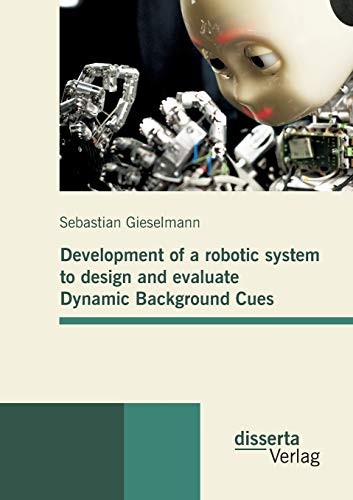Development of a robotic system to design and evaluate Dynamic Background Cues - Softcover

"synopsis" may belong to another edition of this title.
"About this title" may belong to another edition of this title.
- Publisherdisserta verlag
- Publication date2013
- ISBN 10 3954252465
- ISBN 13 9783954252466
- BindingPaperback
- Number of pages272
Buy New
Learn more about this copy
Shipping:
£ 9.98
From United Kingdom to U.S.A.
Top Search Results from the AbeBooks Marketplace
Development of a robotic system to design and evaluate Dynamic Background Cues
Book Description Condition: New. PRINT ON DEMAND Book; New; Fast Shipping from the UK. No. book. Seller Inventory # ria9783954252466_lsuk
Development of a robotic system to design and evaluate Dynamic Background Cues
Book Description PF. Condition: New. Seller Inventory # 6666-IUK-9783954252466
Development of a robotic system to design and evaluate Dynamic Background Cues
Book Description Condition: New. Seller Inventory # ABLIING23Apr0316110172057
Development of a robotic system to design and evaluate Dynamic Background Cues
Book Description Taschenbuch. Condition: Neu. This item is printed on demand - it takes 3-4 days longer - Neuware -When predicting the technological development of assistive systems in everyday environments, it may be assumed that the future home will contain more electronic devices than it does today. We already have a great deal of technology and even robots in our homes. For example, vacuum cleaner robots are used to clean floors fully autonomously. People are becoming more accustomed to robots. Even the elderly are learning to interact naturally with the seal robot Paro.However, problems may emerge as robots become more and more human-like. But, as robots are developed to address more complex tasks, i.e. for serving as social interfaces or housekeeping, it becomes more reasonable to design human-like robots. This shape has the advantage that the interaction becomes more natural. But, it is exactly this human-like shape that often evokes fear and discomfort. When the robot becomes too human-like or too powerful and intelligent, especially people in the western world become scared. This vision of what robots could be or do in the future can be seen in literature or movies where authors express the fear that robots could become dangerous for humans, as seen in the Terminator movies or in Isaac Asimov s I, Robot . This leads people to have an incorrect view of what real humanoid robots are like. In order to reduce these fears, it has become important to convince people that robots are friendly and that it is pleasant to interact with them.Therefore, this book aims to evaluate the effects of social behavior of robots onto the human observer. Is it possible to let a robot appear more social and less frightened by just changing the way the robot moves Is it possible to improve the performance of a cooperative task of a human and a robot by using human-like cues The research is based on a structured investigation of the influence of several movement patterns like breathing, blinking and natural movements. Further, an extensive interaction study was done whereby biophysiological measurements were used in order to evaluate the reaction of the human body onto the robot whole body behavior. 272 pp. Englisch. Seller Inventory # 9783954252466
Development of a robotic system to design and evaluate Dynamic Background Cues
Book Description PAP. Condition: New. New Book. Shipped from UK. THIS BOOK IS PRINTED ON DEMAND. Established seller since 2000. Seller Inventory # L0-9783954252466
Development of a robotic system to design and evaluate Dynamic Background Cues
Book Description Taschenbuch. Condition: Neu. nach der Bestellung gedruckt Neuware - Printed after ordering - When predicting the technological development of assistive systems in everyday environments, it may be assumed that the future home will contain more electronic devices than it does today. We already have a great deal of technology and even robots in our homes. For example, vacuum cleaner robots are used to clean floors fully autonomously. People are becoming more accustomed to robots. Even the elderly are learning to interact naturally with the seal robot Paro.However, problems may emerge as robots become more and more human-like. But, as robots are developed to address more complex tasks, i.e. for serving as social interfaces or housekeeping, it becomes more reasonable to design human-like robots. This shape has the advantage that the interaction becomes more natural. But, it is exactly this human-like shape that often evokes fear and discomfort. When the robot becomes too human-like or too powerful and intelligent, especially people in the western world become scared. This vision of what robots could be or do in the future can be seen in literature or movies where authors express the fear that robots could become dangerous for humans, as seen in the Terminator movies or in Isaac Asimov s I, Robot . This leads people to have an incorrect view of what real humanoid robots are like. In order to reduce these fears, it has become important to convince people that robots are friendly and that it is pleasant to interact with them.Therefore, this book aims to evaluate the effects of social behavior of robots onto the human observer. Is it possible to let a robot appear more social and less frightened by just changing the way the robot moves Is it possible to improve the performance of a cooperative task of a human and a robot by using human-like cues The research is based on a structured investigation of the influence of several movement patterns like breathing, blinking and natural movements. Further, an extensive interaction study was done whereby biophysiological measurements were used in order to evaluate the reaction of the human body onto the robot whole body behavior. Seller Inventory # 9783954252466
Development of a robotic system to design and evaluate Dynamic Background Cues
Book Description PAP. Condition: New. New Book. Delivered from our UK warehouse in 4 to 14 business days. THIS BOOK IS PRINTED ON DEMAND. Established seller since 2000. Seller Inventory # L0-9783954252466

